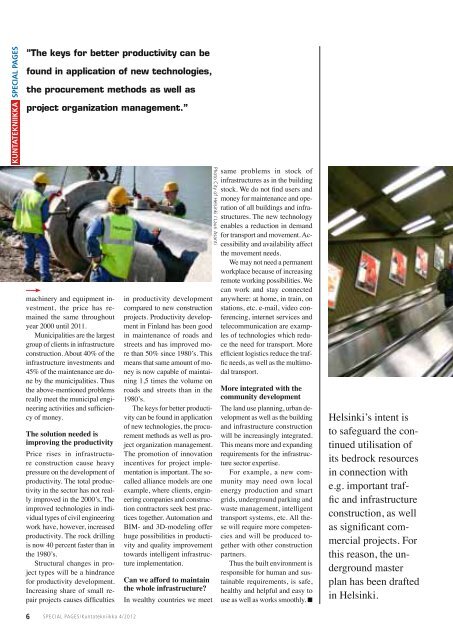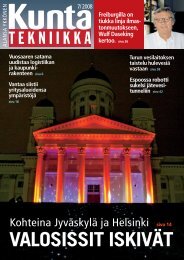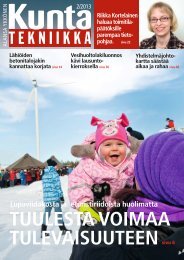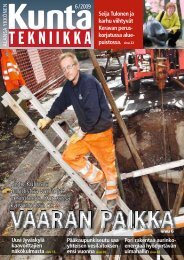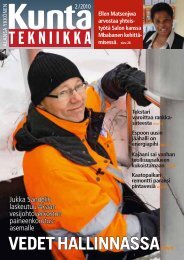Lataa (pdf) - Kuntatekniikka
Lataa (pdf) - Kuntatekniikka
Lataa (pdf) - Kuntatekniikka
Create successful ePaper yourself
Turn your PDF publications into a flip-book with our unique Google optimized e-Paper software.
KUNTATEKNIIKKA SPECIAL PAGES<br />
”The keys for better productivity can be<br />
found in application of new technologies,<br />
the procurement methods as well as<br />
project organization management.”<br />
machinery and equipment investment,<br />
the price has remained<br />
the same throughout<br />
year 2000 until 2011.<br />
Municipalities are the largest<br />
group of clients in infrastructure<br />
construction. About 40% of the<br />
infrastructure investments and<br />
45% of the maintenance are done<br />
by the municipalities. Thus<br />
the above-mentioned problems<br />
really meet the municipal engi-<br />
cy<br />
of money.<br />
The solution needed is<br />
improving the productivity<br />
Price rises in infrastructure<br />
construction cause heavy<br />
pressure on the development of<br />
productivity. The total productivity<br />
in the sector has not really<br />
improved in the 2000’s. The<br />
improved technologies in individual<br />
types of civil engineering<br />
work have, however, increased<br />
productivity. The rock drilling<br />
is now 40 percent faster than in<br />
the 1980’s.<br />
Structural changes in project<br />
types will be a hindrance<br />
for productivity development.<br />
Increasing share of small re-<br />
<br />
in productivity development<br />
compared to new construction<br />
projects. Productivity development<br />
in Finland has been good<br />
in maintenance of roads and<br />
streets and has improved more<br />
than 50% since 1980’s. This<br />
means that same amount of money<br />
is now capable of maintaining<br />
1,5 times the volume on<br />
roads and streets than in the<br />
1980’s.<br />
The keys for better productivity<br />
can be found in application<br />
of new technologies, the procurement<br />
methods as well as project<br />
organization management.<br />
The promotion of innovation<br />
incentives for project implementation<br />
is important. The socalled<br />
alliance models are one<br />
example, where clients, engineering<br />
companies and construction<br />
contractors seek best practices<br />
together. Automation and<br />
BIM- and 3D-modeling offer<br />
huge possibilities in productivity<br />
and quality improvement<br />
towards intelligent infrastructure<br />
implementation.<br />
Can we afford to maintain<br />
the whole infrastructure<br />
In wealthy countries we meet<br />
Photo City of Helsinki / Lauri Asanti<br />
same problems in stock of<br />
infrastructures as in the building<br />
<br />
money for maintenance and operation<br />
of all buildings and infrastructures.<br />
The new technology<br />
enables a reduction in demand<br />
for transport and movement. Accessibility<br />
and availability affect<br />
the movement needs.<br />
We may not need a permanent<br />
workplace because of increasing<br />
remote working possibilities. We<br />
can work and stay connected<br />
anywhere: at home, in train, on<br />
stations, etc. e-mail, video conferencing,<br />
internet services and<br />
telecommunication are examples<br />
of technologies which reduce<br />
the need for transport. More<br />
-<br />
dal<br />
transport.<br />
More integrated with the<br />
community development<br />
The land use planning, urban development<br />
as well as the building<br />
and infrastructure construction<br />
will be increasingly integrated.<br />
This means more and expanding<br />
requirements for the infrastructure<br />
sector expertise.<br />
For example, a new community<br />
may need own local<br />
energy production and smart<br />
grids, underground parking and<br />
waste management, intelligent<br />
transport systems, etc. All these<br />
will require more competencies<br />
and will be produced together<br />
with other construction<br />
partners.<br />
Thus the built environment is<br />
responsible for human and sustainable<br />
requirements, is safe,<br />
healthy and helpful and easy to<br />
use as well as works smoothly. <br />
Helsinki’s intent is<br />
to safeguard the continued<br />
utilisation of<br />
its bedrock resources<br />
in connection with<br />
e.g. important traf-<br />
<br />
construction, as well<br />
mercial<br />
projects. For<br />
this reason, the underground<br />
master<br />
plan has been drafted<br />
in Helsinki.<br />
6 SPECIAL PAGES/<strong>Kuntatekniikka</strong> 4/2012


